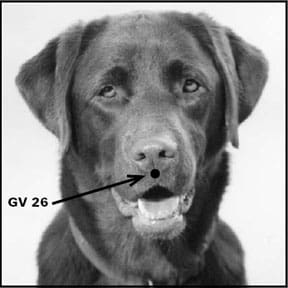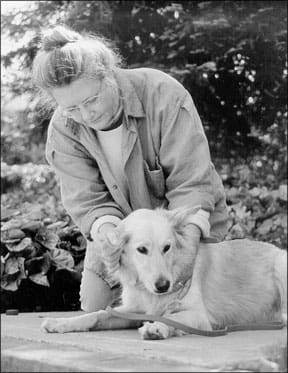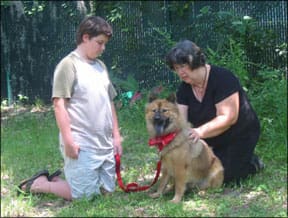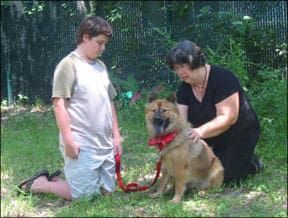We call it the spark of life for good reason. From birth to death, all living creatures generate and transmit energy.
Entire healing therapies, some of them thousands of years old, have been built around energy. Once dismissed by Western science as impossible or ridiculous – and still viewed with suspicion by conventional physicians and canine veterinarians – energy medicine is slowly gaining acceptance in the United States. Several energy therapies are taught in American universities or are used by a growing number of healthcare practitioners. Can canine energy therapies help your dog? The descriptions and resources provided here may help you decide.

288
We’re electric
All living beings generate and transmit electricity. Medical doctors measure it with electroencephalograms (EEGs) and electrocardiograms (ECGs or EKGs). Scientists routinely describe the nervous system in electrical terms, referring to its transducers, transmitters, electrochemical potential circuitry, current, resistance, voltage, capacity, and charge. The brain contains billions of neurons, which are cells that communicate using electrical signals and chemical messengers called neurotransmitters. The connections between neurons (called synapses) measure electrical impulses and transmit the neuron-to-neuron messages that are the foundation of brain function. Everything about the physiology, chemistry, and electrical circuitry of the nervous system has become fodder for medical research!
But Western medicine only maps and measures the body’s electrochemical output. When it attempts to change, balance, or improve the system, it almost always does so with invasive procedures, prescription drugs, or devices like surgically implanted pacemakers. In contrast, energy healing techniques can detect and correct energy imbalances in a noninvasive manner. Practitioners perceive these energy imbalances as the root cause of disease and discomfort.
Some types of energy medicine require the use of special equipment, such as acupuncture needles or grounding technology; in other systems, energetically charged substances, such as canine homeopathic remedies and flower essences, are used to correct energy imbalances. In some systems, practitioners employ physical touch, such as acupressure, meridian tapping techniques, applied kinesiology, and the laying on of hands; in others, the practitioners work close to the patient but do not use physical touch; in still others, the techniques are performed at a distance from the patient.
Skeptics dismiss any benefits observed from energy healing as a result of the placebo effect – where any observable health improvements cannot result from treatment but are attributed to the patient’s beliefs, hopes, and suggestibility. Psychology is a powerful force, but when canine patients improve overnight, their belief in the benefits of a specific therapy is an unlikely explanation for their improvment!
Some critics warn that the use of energy techniques can delay diagnosis, interfere with proper medical treatment, or create complications. However, most energy practitioners consider themselves part of the patient’s therapeutic team, not the sole healthcare provider, and they recommend appropriate veterinary care. In fact, some energy practitioners accept new patients only if they have been referred by a veterinarian. And a growing number of veterinarians administer energy healing techniques themselves, or work with energy practitioners.
Energy techniques are often used as support therapies. Learning how to use one or more of these methods may help both you and your dog in emergencies, and they may improve the outcome of veterinary treatment. Best of all, if an energy technique doesn’t work – and nothing works for everyone – it’s extremely unlikely to cause harm.
Occasionally a study involving an aspect of energy healing, such as the power of prayer, will be published in a major medical journal, but for the most part, research into what science calls the paranormal receives little public attention. Yet in quantum physics and in the field of consciousness research, rigorous scientific experiments have led to fascinating discoveries about the nature of energy and its effect on everything and everyone.
Medical journalist Lynne McTaggart has spent years translating technical scientific literature for lay readers, and her books The Field: The Quest for the Secret Forces of the Universe and The Intention Experiment: Using Your Thoughts to Change Your Life and the World review and explain the findings of hundreds of scientists. “Hidden within the cautious, neutral language of experimental data and mathematical equations,” she writes, “is nothing less than the makings of a new world, which slowly takes shape for all the rest of us, one painstaking experiment at a time.”
Recent discoveries about the brain and nervous system, chemical changes in molecules, communication between neurons, remote healing experiments, the power of intention (thought focused for a specific purpose), and other scientific findings explain why so many physicists and medical researchers consider energy healing not only theoretically possible but a fact of life.
Acupuncture
The most famous of all energy healing techniques is acupuncture, developed more than 5,000 years ago and still a primary healing modality for millions, including dogs, cats, horses, and other animals.
The foundation of acupuncture is a system of invisible channels or meridians through which the body’s energy, or chi, flows. Each meridian is linked to a different organ or body part. Blocks or obstructions in meridian energy reflect imbalances or illness in corresponding organs. To repair both problem and patient, key points along affected meridians are stimulated, releasing energy blocks and restoring balance to the body’s energy flow.

288
Acupuncture points, or acupoints, can be stimulated by the insertion of needles, the application of heat (called moxibustion, in which burning herbs are held just above specific points), acupressure (finger or thumb pressure, massage, or tapping on acupoints), or techniques that utilize electrical or ultrasound stimulation, the implantation of substances such as small gold beads, the application of laser light, or the application of small adhesive magnets.
The acupuncture needles used for dogs are so thin that their insertion is usually painless, although when first experiencing acupuncture, many dogs soon shake their needles out. In some cases insertion causes a brief, sharp pain or discomfort. People receiving acupuncture have the same reactions. Dogs who receive acupuncture weekly or monthly become accustomed to the procedure and often enjoy it, especially when it relieves their chronic pain.
Stacey Hershman, DVM, who makes house calls in Rockland County, New York, and is certified by the International Veterinary Acupuncture Society (IVAS), uses acupuncture to treat many disorders, especially immune system problems, arthritis, and pain from pre- and post-operative hip and knee surgery. “It also helps with torn ligaments, muscle sprains, panosteitis, hip dysplasia, and partial paralysis due to slipped discs,” says Dr. Hershman.
Acupuncture can also be used to help treat behavioral disorders; skin problems such as allergic dermatitis, hot spots, or lick granulomas; respiratory problems; digestive disorders; reproductive problems; hormonal imbalances; burns and other injuries; and any chronic or acute condition.
The technique does not address symptoms the way conventional medicine does. Instead, it stimulates healing from within, allowing the body to repair itself.
Treatment time varies from 10 seconds to half an hour or more. For a simple acute problem, such as a sprain or infection, a single treatment may be all that’s needed. For established conditions, such as arthritis, one to three treatments per week may be necessary at first.
According to IVAS, “A positive response is usually seen after the first to third treatment. Once a maximum positive response is achieved (usually after four to eight treatments), treatments are tapered off so that the greatest amount of symptom-free time elapses between them.” Most dogs with chronic conditions receive two to four maintenance treatments per year. Canine athletes may benefit from one or two treatments weekly or monthly, depending on their activity level and condition.
Acupuncture’s results are often subtle but they can be dramatic. In his book Love, Miracles and Animal Healing, Alan Schoen, DVM, describes how, shortly after he gave an acupuncture demonstration at a veterinary clinic, technicians rushed into the emergency room with a 12-year-old German Shepherd whose heart had stopped after surgery. The veterinarians on duty inserted a tube down the dog’s throat, administered manual cardiac massage, injected the dog with epinephrine and bicarbonate, then wired him to electrodes and gave him electric shocks.
The dog’s EKG traced a flat line and he was pronounced dead. A technician was about to disconnect the oxygen when Schoen asked if he could try. He inserted an acupuncture needle at the center of the dog’s upper lip, halfway between nose and mouth, and gave it several short jabs. Within seconds, the dog began breathing and his heartbeat resumed.
Dr. Schoen wants everyone to know about this acupuncture point, called GV 26, a point on the Governing Vessel meridian. This emergency point can be stimulated with an acupuncture needle or fingernail to revive an unconscious animal.
Like all energy therapies, acupuncture can be used to alleviate, improve, or cure acute or chronic conditions and to help keep problems from developing when used as a preventive therapy.
Acupressure
Acupressure utilizes the same meridians as acupuncture, but instead of needles, pressure from the ball of the thumb, the tip of the index or middle finger, or the bent index finger’s knuckle (if nails are long) stimulates the meridians’ key points.
Acupressure is a versatile healing tool, one that can address obvious problems like sports injuries as well as more complex conditions, like auto-immune disorders or behavioral issues.

288
Frequent Whole Dog Journal contributors and acupressure experts Amy Snow and Nancy Zidonis, authors of The Well-Connected Dog: A Guide to Canine Acupressure and other books, offer introductory, intermediate, and advanced training in Traditional Chinese Medicine and acupressure for horses, dogs, and other animals at their Tallgrass Animal Acupressure Institute in Larkspur, Colorado. Graduate practitioners from Tallgrass span the globe.
In their Canine Acupressure workbook, Snow and Zidonis give step-by-step instructions for locating and stimulating about 150 major acupressure points, with treatment programs for commonly seen problems, such as lower back soreness, neck stiffness, and hip problems.
While acupuncture needles must be positioned precisely, acupressure is forgiving because fingertips cover a wider area. This noninvasive treatment can safely be learned and used by pet owners as well as by trainers and healthcare practitioners.
Acupressure performed mechanically can clear energy blocks and improve health, but Snow and Zidonis train their students as much in breathing and focusing their thoughts as in the location of meridians and pressure points. “Acupressure has the added benefit of contributing human intention and energy to the dog during the process of balancing physical and emotional issues,” says Snow. “In several ways, this makes the acupressure more powerful and effective.”
Acupressure sessions typically last 20 minutes to one hour, beginning with opening work (centering yourself, positioning the dog, and gliding the palms over the animal’s body), followed by point work (stimulating individual acupressure points), closing (all-over massage with a smooth, light touch), and 5 to 10 minutes of gentle stretching.
“The best part of acupressure,” says Snow, “is that it is always available. We have seen many who, even as novices, provided healing help for their animals after learning some basic energy balancing techniques. Not everyone wants to be a practitioner, but everyone can use acupressure to support their dog’s physical and emotional well-being.”
Tellington TTouch
When Israeli physicist and athlete Moishe Feldenkrais was hit by a bus and lost the use of his legs, he refused surgery and ignored his doctors’ pessimistic predictions. Instead, he re-educated his legs by bypassing the habitual ways in which he moved, utilizing every alternative motion he could discover, from gross muscle movement to the smallest and most subtle flexing. Within two years, he was walking again – and his discoveries improved the lives of those with obvious disabilities as well as dancers, athletes, and people who wanted to enhance their performance. He taught them how to walk, run, speak, think, and move in entirely new ways.
The practitioners he trained in Awareness through Movement or the Feldenkrais Method of Functional Integration spent hundreds of hours lying on the floor, studying and experiencing minute muscle movements.
One of Feldenkrais’ students was Linda Tellington-Jones, who realized that horses and other animals could, like people, learn new responses very quickly if their old habit patterns were disrupted in a non-threatening manner. Her method, Tellington TTouch (pronounced tee-touch), has transformed dogs, cats, horses, cows, goats, birds, reptiles, and zoo animals, as well as their owners, companions, and caregivers. Tellington-Jones describes TTouch as affecting living beings at the cellular level, thus activating the body’s potential.
TTouch borrows some of its procedures from auricular medicine, an acupuncture technique that stimulates acupoints on the ear to treat the entire body. Additional body touches, small circular movements, lifts, and slides are performed with the hands and fingertips, and dogs are wrapped in elastic bandages, stroked with wands, and walked through labyrinths, all in an effort to interrupt and permanently change their habitual thoughts, reactions, and motions.
TTouch practitioners and instructors use the technique to help dogs overcome fear, improve their coordination, prevent injuries, improve their focus and concentration, and reduce the stress in their lives. The technique has helped dogs overcome separation anxiety, improve obedience, reduce excessive barking and chewing, and diminish aggressive behavior.
Thanks to the many books, videos, DVDs, and training aids created by Linda Tellington-Jones, anyone with a love of animals can learn TTouch at home. More than 1,000 certified practitioners in the U.S. and 25 other countries provide in-person instruction and treatment sessions.
Now that TTouch has been helping dogs and other animals for almost 25 years, Linda Tellington-Jones has introduced something new – her latest TTouch method, called TTouch-for-You, is for people.
Therapeutic Touch
In the early 1970s, Dolores Krieger, PhD, a registered nurse and professor at the New York University Graduate School of Nursing, and her mentor, Dora Kunz, developed a secular, nonreligious form of healing that combined the laying on of hands – the world’s oldest healing method – with other traditional energetic techniques.
The result, which they called Therapeutic Touch, was first taught to nurses at NYU. Today Therapeutic Touch is taught in over 200 hospitals and more than 100 accredited colleges and universities in the United States, as well as in 75 countries around the world.
Best known for its ability to relieve stress and anxiety, Therapeutic Touch has been credited with reducing pain, improving immune function, speeding wound healing, and improving overall health. It has been tested in numerous research studies that document physiological changes within the body, including changes in brain wave patterns.
Despite its name, Therapeutic Touch is a hands-off healing method, for it doesn’t involve physical contact. The technique is performed in three main steps. First, the practitioner centers himself or herself by quieting the mind.
Next, with hands placed two to six inches from the patient, the practitioner scans the patient’s body using slow, rhythmic motions to locate energy blocks.
Last, the energy blocks are released as the practitioner visualizes and smoothes the patient’s energy field from head to toe. Sessions typically last from 20 to 30 minutes.
Carol Robin, DC, a chiropractor in West Shokan, New York, learned Therapeutic Touch as an adjunct to her professional practice. When she tried it on her dog and three cats, they responded as well as her human patients. She then began teaching Therapeutic Touch and Energy Balancing to pet owners.
“This method is a powerful tool for centering, relaxing, and grounding,” she says, “and it helps with behavior problems as well as physical ailments. If dogs are hyper or nervous, it calms them down. If they’re afraid of thunderstorms or strange noises, it can help them be less fearful. In cases of injury or illness, it helps them relax and gets their energy flowing more freely to speed up the healing process. I can’t think of any condition where Therapeutic Touch would not be helpful.”
Dr. Robin’s instructions are simple. After relaxing, grounding yourself, and focusing your attention on your dog, place one hand on the head and the other just above the tail at the base of the spine, over the sacrum. Touching lightly with the palms of the hands, or on a small or toy breed, with your fingertips, imagine energy flowing like water from the dog’s head, down the spine, and out the end of the tail. Hold the position for a minute or two, until you feel a sense of balance under your hands and the dog begins to relax.
Light strokes from head to tail and from spine to paws distribute the energy throughout the dog’s body, clear energy imbalances, and facilitate healing.
“The most important thing to do before you begin,” says Dr. Robin, “is to take a few deep breaths and center yourself. If you’re upset or distracted, you’ll only agitate the dog. If your intention is loving and healing, your efforts will assist your animal companion.”
To help those who are unfamiliar with the preliminary steps of Therapeutic Touch, Dr. Robin has recorded guided meditation and imagery CDs. “They’re for anyone who would like to relax and explore the physical, emotional, mental, and spiritual levels of body, heart, mind, and spirit,” she says, “all of which enhance your application of Therapeutic Touch.”
Reiki
Reiki (pronounced RAY-kee) was developed in Japan in the late 19th century and is taught in an oral tradition of master-to-student instruction. The Reiki practitioner becomes the conduit for transmitting universal energy to the client’s energy field by means of an “attunement” from a Reiki Master. Practitioners usually describe their work as bringing the body into harmony and balance. Reiki is used for all types of physical, mental, emotional, and spiritual healing. In addition to relieving physical symptoms, it enhances personal growth, speeds the healing of injuries, and reduces stress.

288
In Reiki, intention is everything. Practitioners agree that having the right mental focus is more important than holding your hand in an exact position. So long as your intention is to channel universal energy for the highest good of the person or animal you’re working with, the same positive impact will result.
Level 1 Reiki students practice being a conduit of healing energy for themselves and others at close proximity. In Level 2, students learn three ancient symbols that can be used to focus healing, intensify the energy flow, and transmit Reiki across greater distances. Level 2 Reiki is especially useful when working with dogs and other creatures, including wild, aggressive, abused, traumatized, and seriously ill animals. Level 3 produces Reiki Masters, who are the most advanced practitioners.
Only a few formal studies have examined Reiki’s effectiveness, and of these, most dealt with pain. Reiki has been shown to be highly effective in managing pain from various causes, including cancer, arthritis, and sinus infections. However, Reiki practitioners report the healing of a wide variety of illnesses. It is one of the world’s most widely used energy therapies. In Orange Park, Florida, dog trainer and behavioral consultant Elizabeth Teal was completing her Level 3 Masters training when she used Reiki to break up a dog fight.
“The two dogs were part of a recently combined family, so they knew each other, but not well,” says Teal. “One was a highly spoiled, resource-guarding terrier belonging to the client’s mother-in-law. The other was a territorial, defensively aggressive, recently rescued spaniel belonging to the client’s child. These dogs did not speak the same language. The kitchen was already crowded when the doorbell rang because both owners were trying to feed their dogs at the same time. Tensions were high. A third person, a visitor, entered the kitchen, and I came in last. Suddenly, all hell broke loose. Everyone was screaming, including the dogs, and blood was flying.”
Reiki treatments begin with the practitioner asking permission to proceed, which animals indicate with their posture, breathing, and body language, but this was an emergency. Reiki instructors explain that in emergencies, the higher self of all concerned directs the energy.
“The first thing I did was clear the room,” says Teal. “It took a minute to accomplish this, but as soon as the people left, I drew a power symbol and a relationship symbol over the area. The terrier still had a serious hold on the spaniel. I knew that if I put my hands near the dogs, I would be attacked.
“I held my hands to either side of both dogs and focused my mind. What happened next wasn’t like a jolt of lightning or an explosion, but I felt a whoosh, and a wave of quiet filled the room. At that instant, both dogs stopped, stood still, and stared straight at me. That gave me just enough room to grab their collars, toss them in their crates, and kick the doors closed.”
Teal and her client took both dogs to the nearest veterinary clinic, where the spaniel was treated for multiple bite wounds, requiring stitches. The terrier has since been re-homed.
“I’d like to add a note of caution,” she says. “Dog fights are very, very serious, and I’m not by any stretch of the imagination suggesting that you learn Reiki because it will break up dog fights. Also, dogs should never be put in situations where they have to use their weapons. This fight could and should have been prevented, but that’s a separate story.”
After she completed her Masters training, Teal began working with animals and their human and animal families. “I’m more interested in emotional healing than physical healing,” she explains, “and I may specialize in re-homed animals, who often have complex issues. Reiki is the best tool I can imagine for helping these special pets.”
For an excellent introduction to Reiki for pets, see Animal Reiki: Using Energy to Heal the Animals in Your Life, by Elizabeth Fulton and Kathleen Prasad.
Coming next month: Animal communication, applied kinesiology, flower essences, homeopathy, and more.
CJ Puotinen, a frequent contributor to WDJ, is the author of The Encyclopedia of Natural Pet Care, which describes several energy healing techniques.






